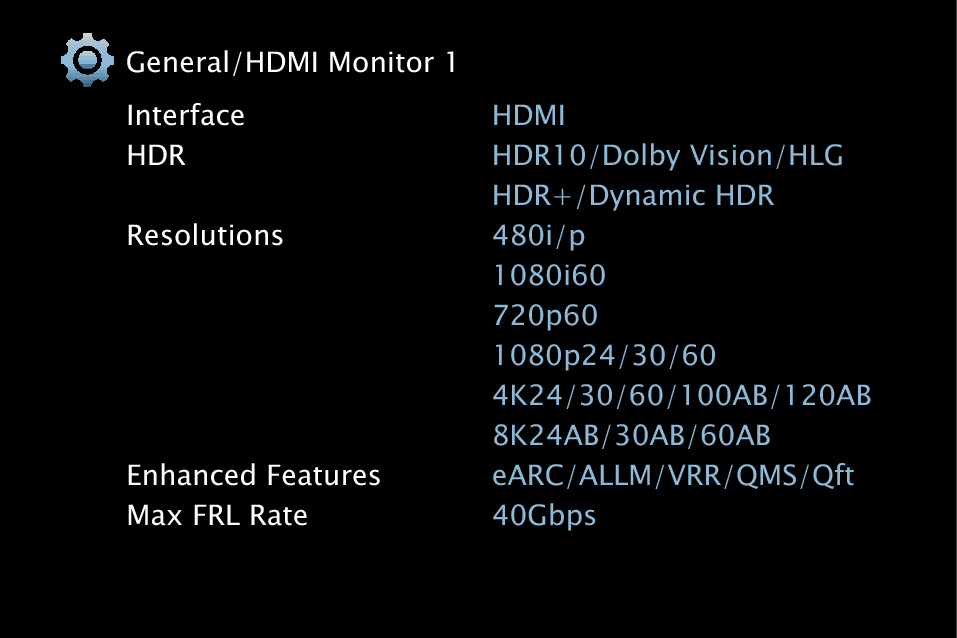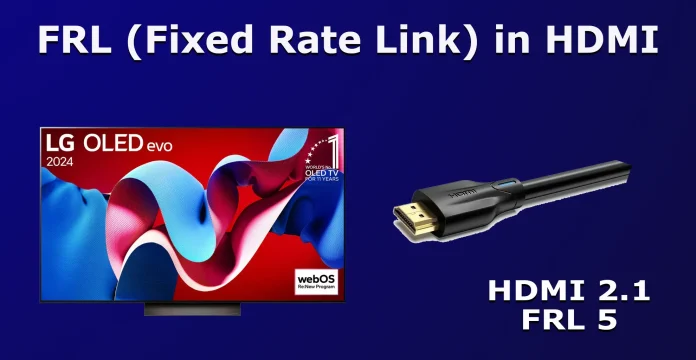In modern TVs and other devices, you may find a port that supports FRP. If you want to know what it is, here’s an explanation.
FRP (Fixed Rate Link) is a new transfer protocol used in HDMI 2.1 that allows you to transfer video at a fixed rate from one device to another, such as from a game console to a TV. The fixed rate has six fixed stages from 6 Gbps to 48 Gbps. This protocol was designed for newer TVs and monitors that support high frame rates and resolutions. A special high-speed HDMI cable is required to connect FRP-enabled HDMI ports.
FRL fixed data rates
FRL supports six data rates with 3 to 4 channels. Support for three channels is implemented to be compatible with the old TMDS protocol, which provided data rates up to 18 Gbit/s.
In practice, the rate is set as follows: the highest possible rate supported by the receiver is selected. If the TV or monitor does not support FRL, then the protocol will not be used, and the transmission will take place via TMDS protocol, which provides backward compatibility with older TVs and monitors.
Table of speeds supported by HDMI ports with FRP
| FRL rate | channels used | bit rate per channel | total speed |
|---|---|---|---|
| FRL1 | 3 | 3Gbps | 9Gbps |
| FRL2 | 3 | 6Gbps | 18Gbps |
| FRL3 | 4 | 6Gbps | 24Gbps |
| FRL4 | 4 | 8Gbps | 32Gbps |
| FRL5 | 4 | 10Gbps | 40Gbps |
| FRL6 | 4 | 12Gbps | 48Gbps |
Each speed is designed for specific video quality, such as resolution, video subsampling (compressing the transmitted video using specific algorithms), and color depth in the video. For example, FRL6 works for 4K and 8K video with 12-bit color depth. And today, no TV set supports 12-bit color depth. So 48Gbps is redundant today, and the standard is designed for the future, but manufacturers, especially cable products, widely use this term for marketing purposes.
HDMI RFL, table of supported resolutions, subsamples, color depths
The speed is set on connection; consider an example: you have a PS5 console and a TV with UHD resolution, 10-bit color depth, HDMI 2.1 port supports 120Hz, 120fps, and you run a game that supports 4K resolution, 120fps. When connected, the PS5 will receive information from your TV that it supports the video parameters; for example, the TV has informed the console that it supports 40Gbps; in this case, the connection will be established using the FRL5 protocol, which supports subsampling 4.4.4 (no quality loss) with a color depth of 10 bits and a frame rate of 120.
Table of supported resolutions, subsamples, color depths by FRL levels
| Fixed Rate Link | |||||
| FRL Rate | Resolution | Frame Rate | Sampling | Depth | Bandwidth |
| FRL 1 | 1080P | 120Hz | 4:4:4 | 8 Bit | 9 Gbps |
| 1080P | 120Hz | 4:2:2 | 8-12 Bit | 9 Gbps | |
| 4K | 30Hz | 4:4:4 | 8 Bit | 9 Gbps | |
| 4K | 30Hz | 4:2:2 | 8-12 Bit | 9 Gbps | |
| 4K | 60Hz | 4:2:0 | 8 Bit | 9 Gbps | |
| FRL 2 | 1080P | 120Hz | 4:4:4 | 10-12 Bit | 18 Gbps |
| 4K | 30Hz | 4:4:4 | 10-12 Bit | 18 Gbps | |
| 4K | 60Hz | 4:4:4 | 8-12 Bit | 18 Gbps | |
| 4K | 60Hz | 4:2:2 | 8-12 Bit | 18 Gbps | |
| 4K | 60Hz | 4:2:0 | 10-12 Bit | 18 Gbps | |
| 4K | 120Hz | 4:2:0 | 8 Bit | 18 Gbps | |
| 5K | 30Hz | 4:4:4 | 8-12 Bit | 18 Gbps | |
| 5K | 30Hz | 4:2:2 | 8-12 Bit | 18 Gbps | |
| 5K | 60Hz | 4:2:0 | 8-12 Bit | 18 Gbps | |
| 8K | 30Hz | 4:2:0 | 8 Bit | 18 Gbps | |
| FRL 3 | 4K | 120Hz | 4:2:0 | 10-12 Bit | 24 Gbps |
| 4K | 120Hz | 4:2:0 | 10-12 Bit | 24 Gbps | |
| 5K | 60Hz | 4:4:4 | 8 Bit | 24 Gbps | |
| 5K | 60Hz | 4:2:2 | 8-12 Bit | 24 Gbps | |
| 5K | 120Hz | 4:2:0 | 8 Bit | 24 Gbps | |
| 8K | 30Hz | 4:2:0 | 10-12 Bit | 24 Gbps | |
| 10K | 30Hz | 4:2:2 | 8 Bit | 24 Gbps | |
| FRL 4 | 4K | 120Hz | 4:2:2 | 8-12 Bit | 32 Gbps |
| 4K | 120Hz | 4:4:4 | 8 Bit | 32 Gbps | |
| 5K | 60Hz | 4:4:4 | 8-12 Bit | 32 Gbps | |
| 5K | 120Hz | 4:2:2 | 8-12 Bit | 32 Gbps | |
| 8K | 30Hz | 4:4:4 | 8 Bit | 32 Gbps | |
| 8K | 30Hz | 4:2:2 | 8-12 Bit | 32 Gbps | |
| 8K | 60Hz | 4:2:2 | 8 Bit | 32 Gbps | |
| 10K | 30Hz | 4:2:2 | 10-12 Bit | 32 Gbps | |
| FRL 5 | 4K | 120Hz | 4:4:4 | 10 Bit | 40 Gbps |
| 5K | 120Hz | 4:4:4 | 8 Bit | 40 Gbps | |
| 5K | 120Hz | 4:2:2 | 8-12 Bit | 40 Gbps | |
| 8K | 30Hz | 4:4:4 | 10 Bit | 40 Gbps | |
| 8K | 60Hz | 4:2:0 | 10 Bit | 40 Gbps | |
| 10K | 30Hz | 4:4:4 | 8 Bit | 40 Gbps | |
| 10K | 30Hz | 4:2:2 | 8-12 Bit | 40 Gbps | |
| 10K | 60Hz | 4:2:0 | 8 Bit | 40 Gbps | |
| FRL 6 | 4K | 120Hz | 4:4:4 | 12 Bit | 48 Gbps |
| 8K | 30Hz | 4:4:4 | 12 Bit | 48 Gbps | |
| 8K | 60Hz | 4:2:0 | 12 Bit | 48 Gbps | |
How to find out which FRP (Fixed Rate Link) your monitor or TV supports.
FRP is only available in HDMI 2.1, and which type is supported depends on the chip manufacturer. The HDMI 2.1 specification does not require strict adherence to standards, the manufacturer only needs to fulfill one parameter from the 2.1 standard and it can designate the port as HDMI 2.1.
To find out the HDMI parameters of your monitor or TV set
To do this, you can connect a leptop to your TV or monitor and find a special program that will read information about the HDMI of the TV.

The second method is simpler and is based on analyzing available information. For example, in the specifications of Samsung 2024 TV model DU8000 it is stated that there are HDMI 2.1 ports and support for 4K/60Hz. Look at the table, this frequency is only supported by FRL1, FRL2. Hence, your TV only supports these standards. The FRL protocol resides in the HDMI chip, so it is not possible to update the FRL levels programmatically.




